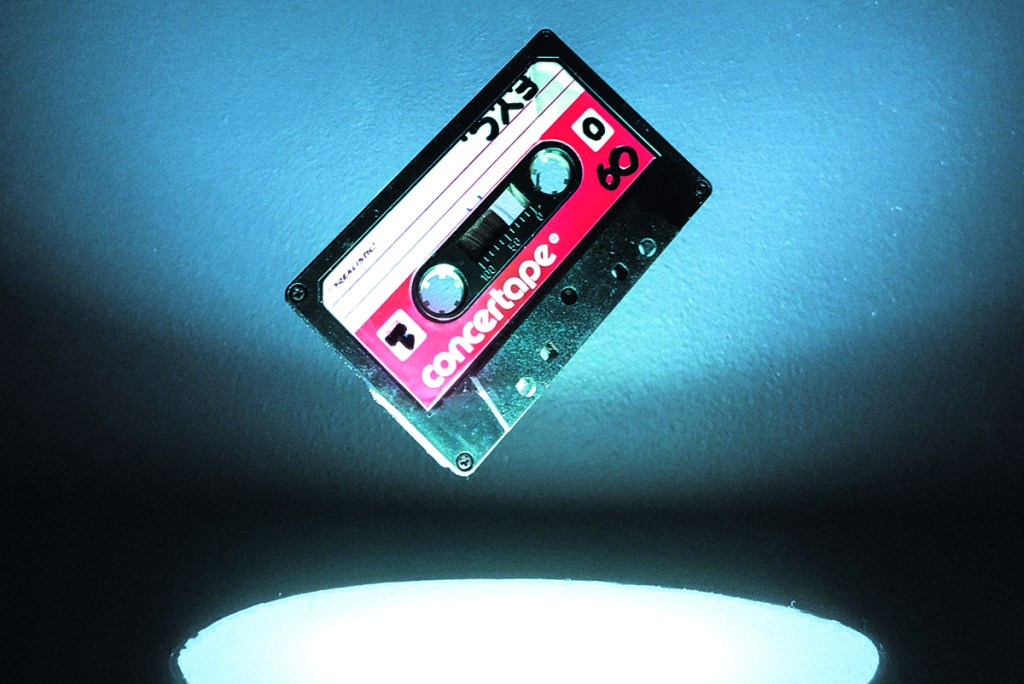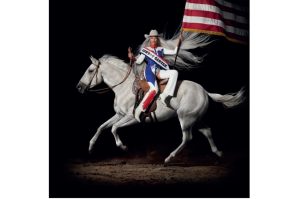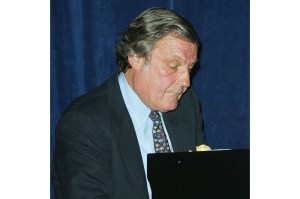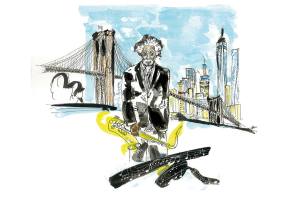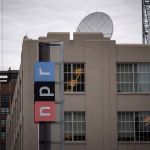I must have been about 16 when I got my first Portastudio. The compact home recording unit had first been introduced by Japanese electronics firm Teac in 1979, offering unprecedented multitrack dubbing to the bed-bound amateur musician. For a little less than $1,000, you could record four separate tracks of instrumentation — as much as the Beatles had when making Sgt. Pepper — on an ordinary cassette tape. By the time I got my teenage hands on a four-track machine of my own, that price had come down by an order of magnitude. It was a chunky little unit in pigeon blue with just two microphone sockets and a small handful of mixing dials for volume control and stereo panning. Anything you fed into it would be squashed and smudged into its limited dynamic range and smeared all over with a waterfall of tape hiss. But to me that little box was magic.
Recording music myself in the comfort of my bedroom made sound into something plastic. It gave me a sense of agency and allowed me to think in a different, more holistic, but also more experimental way. At that time, most of the songs in the charts and on the radio seemed to be made in big, expensive studios with mixing boards that looked as though they could launch a space shuttle, by highly paid producers wielding microphones that cost, individually, more than everything I owned put together. My friends and I were grabbing beats from the presets on toy Casio keyboards, plugging our guitars directly into the Portastudio jack inputs, then turning the tape over so the sound would play backwards, looping the signal from a daisy chain of cheap effects boxes until it fed back a sound that fooled my friend Marc’s older brother into thinking we had a Moog synthesizer. We bought records by artists with an aesthetic (almost) as scrappy as our own, poring over the badly photocopied sleeves of short-run CDs issued by micro-labels in Nottingham, Wetherby and Olympia, Washington. Never would I have imagined that scarcely more than two decades later, some of the biggest pop stars on the planet would be embracing lo-fi aesthetics and making records in their bedrooms just like us.
Even before the pandemic struck, so-called ‘bedroom pop’ was already becoming one of the fastest growing genres in popular music. Armed with little more than a Macbook Air and a Spotify for Artists account, scores of listless Gen-Z singer-producers such as Clairo, Beabadoobee and mxmtoon racked up hundreds of thousands of streams with their intimate blend of homemade electro-indie, far from the prying bean counters of the mainstream record industry. But since last spring, when the world crawled into lockdown, even major-label artists have been firing up their laptops and embracing a more stripped-back sound. Taylor Swift’s Folklore eschewed the high gloss of 2019’s double platinum selling Lover in favor of a cottagecore aesthetic of gently strummed guitars and puttering 8-bit beats. From the crunchy, glitchy sound of its rhythm tracks to the selfies adorning its sleeve, How I’m Feeling Now, by Swift’s former touring partner Charli XCX, positively revels in its DIY spirit. Elsewhere, artists from Paul McCartney to Little Simz have taken to ad hoc home studios to self-produce records that are notably more minimal in their arrangements, more modest in conception, than their usual run of releases.
But in a way lo-fi is part of pop’s DNA. The record industry was built on big, cavernous studios owned by major labels that were themselves part of even bigger corporations, like Columbia’s famous 30th Street Studios, site of Glenn Gould’s Goldberg Variations and the classic albums of Duke Ellington and Miles Davis, or London’s Abbey Road, where the likes of Edward Elgar and Thomas Beecham conducted the London Symphony Orchestra before it became home to the Beatles. But Sam Phillips’s Memphis Recording Service was just a squat single-story shop front, 80ft by 57ft, which meant the producer had to create the illusion of space with artificial echoes and reverbs. Those effects would soon become defining aspects of the sound of Elvis’s voice — and of rock ’n’ roll records generally. The classic guitar sounds of Ike Turner and the Kinks’s Dave Davies were made using broken amplifiers. Joe Meek — producer of ‘Telstar’, Margaret Thatcher’s favorite pop song — made the cramped conditions of his studio (actually the kitchen of his Holloway Road flat) into a virtue: close-miking instruments for greater control over the sound and driving rudimentary tape effects to excess to create wild explosions of sound.
The early dawn of pop music was also the era of high fidelity, of high-end audio units in gleaming chrome and varnished teak, every woofer carefully crafted and calibrated to give as faithful a picture of the original performance as possible. But the salesmen in high street hi-fi stores were not showing off such expensive devices by playing anything as crude as rock ’n’roll. The ‘golden ears’ of the 1950s and ’60s with their quantitatively specified equalization curves and acoustic suspension were nodding along appreciatively to the smoother sounds of Mantovani and Arthur Lyman. By contrast, the likes of Joe Meek — and even Phil Spector with his ‘wall of sound’ — were making records best suited for cheap, portable AM radios: noisy, punchy and even tinny, without wasting time and money on unnecessary gloss. After all, as Philly soul producer Joe Tarsia would say: ‘What was the sense of filling the record with sounds that could not be heard on the air?’
Lo-fi, as a term, was preceded and prompted by its contrary. Credit for the phrase ‘high fidelity’ is claimed by an English loudspeaker manufacturer named H.A. Harley, who coined the term in 1927. It did not initially take off. So much so that by 1953, Hartley was forced to sell off his company, finding no market for the perfectly faithful reproduction of poor-quality AM radio signals or scratchy Victrola phonographs. Which is a shame, because by 1953 ‘high fidelity’ was on the brink of household recognition and had already spawned the snappier abbreviation, ‘hi-fi’. In the trade press, at least, it had also been joined by its opposite number. But it was never a union of equals.
By 1964, the New York Times was complaining about a ‘low-fi invasion’ of campaign sound trucks blaring garbled political messages from two-bit bullhorns. The pioneering acoustic ecologist Murray Schafer, in his groundbreaking 1977 book The Tuning of the World, spoke of ‘lo-fi soundscapes’, those benighted post-industrial sites in which aural signals become ‘overcrowded, resulting in masking or lack of clarity’ (think of the tumult of competing noises in a subway station at rush hour as opposed to the more equable distribution of sound sources in a meadow or forest).
When Popular Electronics asked its readers, ‘Ever hear of “lo-fi”?’ it was for a feature about a battery-powered ‘supersonic squawker’ intended to dispel pests, a precursor to the high-frequency ‘mosquito’ buzzer controversially employed by a Welsh shopkeeper in the early Noughties to shoo off loitering youths. Audio magazine could be heard muttering darkly about ‘our enemy, lo-fi’. Lo-fi was inevitably a slur — or else a kind of sigil to keep out the encroaching noise of modernity.
If there was ever a ‘golden age’ of lo-fi, it was probably the 1980s. Today, we might picture ’80s music as an era of high gloss and big hair, but there was another side to the era. Bruce Springsteen’s Nebraska was recorded on a first-generation Teac Portastudio and set the stage for the triple-platinum success of Born in the USA. Punk opened up a space for a more ‘do-it-yourself’ approach in every aspect of music-making. Meanwhile, in Austin, Texas, a twenty-something McDonald’s employee with a diagnosis of bipolar disorder was handing out cassette tapes of songs he recorded and duplicated himself in his parents’ basement. Daniel Johnston would become a sort of patron saint of lo-fi. But to a large extent such newfound appreciation for raw recording technique was retrospective. Only at the very end of the 1980s and, increasingly, in the 1990s, was Johnston hailed as a significant practitioner of a ‘lo-fi aesthetic’ (by which time, Johnston had started releasing some studio-recorded albums and his early self-released tapes were being professionally mastered and re-pressed). Contemporary reviews of Nebraska praised its ‘directness’, its ‘unadorned’ arrangements, but not the cheapness of its technical set-up.
I didn’t know it then, but by the time I began my own adventures in home recording, lo-fi was fast becoming an appreciable style of its own. In the mid-1990s, groups such as Pavement, Sebadoh and Guided By Voices were being feted in the New York Times as a new wave of ‘lo-fi rock’, celebrated for their ‘bare bones style’ and ‘stripped-down approach to recording’. The irony is that by that time the raw sound of home recording was more of a choice than an economic necessity. Digital audio workstations such as Cubase and Sound Tools offered unprecedented recording quality and flexibility at a price that was already probably lower than the recording budget of most Pavement records and falling fast.
By the early Noughties, I had abandoned my four-track in favor of a program called GarageBand — the very name evoking a halcyon age of rough-and-ready jam bands — that came free with my laptop. I was far from alone. Major hits by Usher, Grimes and even Rihanna were made using the same software without anyone feeling the need to call them ‘lo-fi’. So when up-and-coming artists today opt for the lo-fi sound, they do so with a peculiar kind of nostalgia: longing for an aesthetic that was already a deliberate confection before they were even born.
This article was originally published in The Spectator’s October 2021 World edition.
